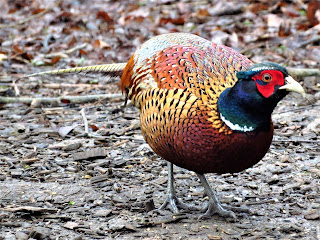Venus Pool
A visit to the SOS reserve at Venus Pool was not entirely successful. I had forgotten that some of the hides would be closed to allow them to be extended. The necessary work had clearly disturbed the birds and there were very few present on the water. I went to the more or less undisturbed woodland hide where, with the rain clouds not entirely cleared it was rather dull, making photography difficult. However ... I persevered. Female ducks are really attractive when seen well: here a duck Mallard of course.
How could I resist another shot? And how could anyone shoot such a magnificent bird.
Ready for another view?
Moorhens are quite colourful when seen in close-up.
Another view (the out-of-focus twig is almost vertical through the bird’s body).
A different view.
Typically the sun came out as I was leaving: a Reed Bunting. Not in full plumage the dark cheeks are sufficient to identify it as a male. In this plumage it is very similar to the rare Rustic Bunting – there was one here last winter. However Rustic Bunting would show a pink bill.
Shawbury
Later I went to Shawbury to watch the helicopters and was distracted by this Kestrel. When you look at illustrations in field guides separation of male and female looks easy. It often isn’t and the only ‘clincher’ for me here is the barring on the edge of the outer tail-feather – so it is a female.
This view we see the whole barred undertail confirming it is a female. A male’s undertail is plain grey with a black tip.
Later I went to Shawbury to watch the helicopters and was distracted by this Kestrel. When you look at illustrations in field guides separation of male and female looks easy. It often isn’t and the only ‘clincher’ for me here is the barring on the edge of the outer tail-feather – so it is a female.
This view we see the whole barred undertail confirming it is a female. A male’s undertail is plain grey with a black tip.
(Ed Wilson)































